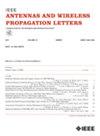用于亚太赫兹应用的紧凑d波段多层喇叭天线与薄3d打印透镜
IF 4.8
2区 计算机科学
Q2 ENGINEERING, ELECTRICAL & ELECTRONIC
引用次数: 0
摘要
本文提出了一种带准光学透镜的d波段多层金属喇叭天线。喇叭是由若干独立的金属层按特定的图案垂直堆叠而成,层与层之间有滑模对称的周期性电磁带隙来抑制表面波。这些金属板是通过线电极切割技术和计算机数控铣削加工的。该透镜是基于高斯光束规则设计的,并采用商用3d打印技术制造。对天线进行了制作和测量。测量结果表明,在120 GHz ~ 160 GHz频段,天线平均增益优于20 dBi,在145 GHz频段,天线平均增益达到22 dBi。该天线具有宽带和低成本的特点,小型化的尺寸使其易于集成到次太赫兹应用系统中。本文章由计算机程序翻译,如有差异,请以英文原文为准。
A Compact D-Band Multilayer Horn Antenna With Thin 3-D-Printed Lens for Subterahertz Applications
A D-band multilayer metallic horn antenna with a quasi-optically designed lens is proposed in this letter. The horn is formed by vertically stacking several independent metal layers with the specific pattern, with glide-symmetric periodic electromagnetic bandgap between the layers to suppress surface waves. These metal plates are processed by wire-electrode cutting technology and computer numerical control milling. The lens is designed based on the Gaussian beam rule and manufactured by commercial 3-D printing technology. The antenna has been fabricated and measured. The measured results show that the average antenna gain is better than 20 dBi at 120 GHz to 160 GHz, and the antenna gain achieves 22 dBi at 145 GHz. The antenna exhibits wideband and low-cost characteristics, and the miniaturized size makes it easy to integrate into subterahertz application systems.
求助全文
通过发布文献求助,成功后即可免费获取论文全文。
去求助
来源期刊
CiteScore
8.00
自引率
9.50%
发文量
529
审稿时长
1.0 months
期刊介绍:
IEEE Antennas and Wireless Propagation Letters (AWP Letters) is devoted to the rapid electronic publication of short manuscripts in the technical areas of Antennas and Wireless Propagation. These are areas of competence for the IEEE Antennas and Propagation Society (AP-S). AWPL aims to be one of the "fastest" journals among IEEE publications. This means that for papers that are eventually accepted, it is intended that an author may expect his or her paper to appear in IEEE Xplore, on average, around two months after submission.

 求助内容:
求助内容: 应助结果提醒方式:
应助结果提醒方式:


